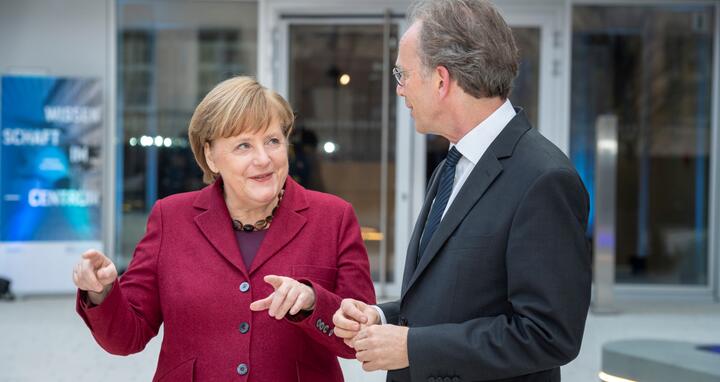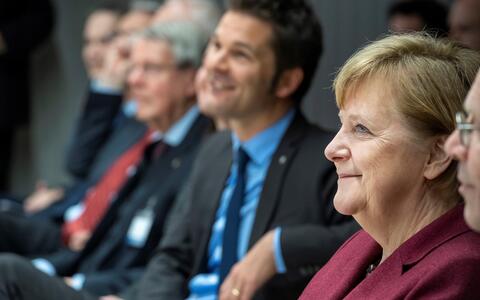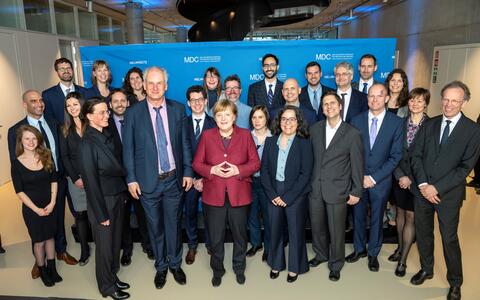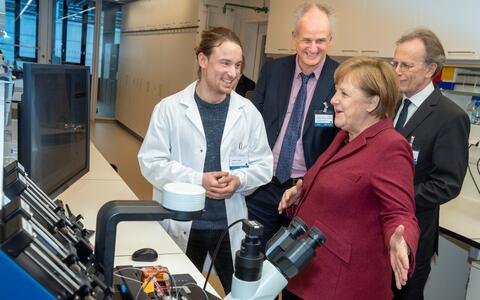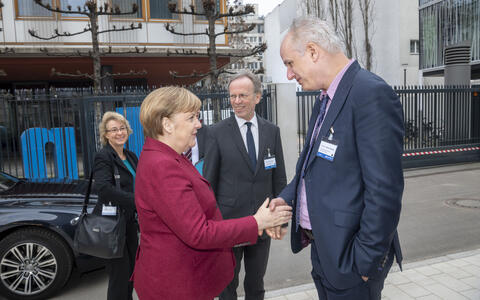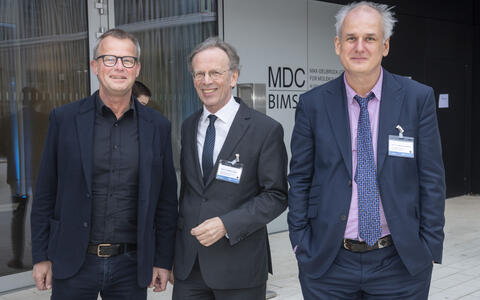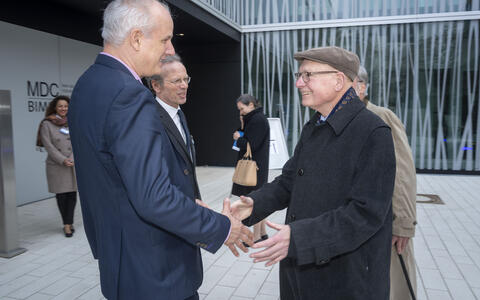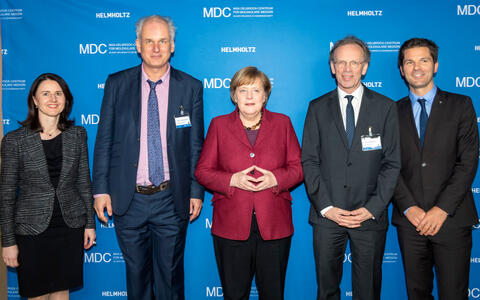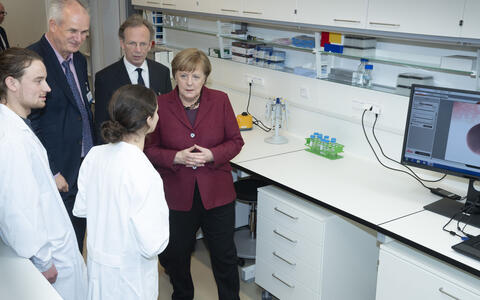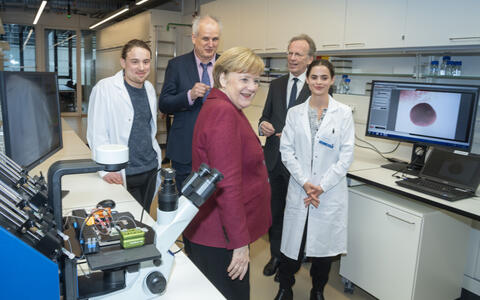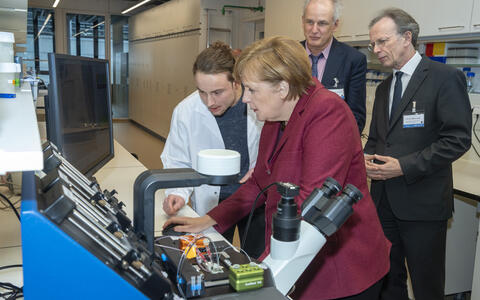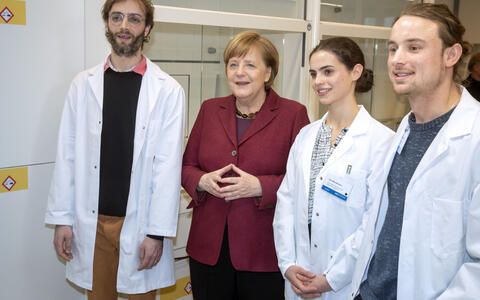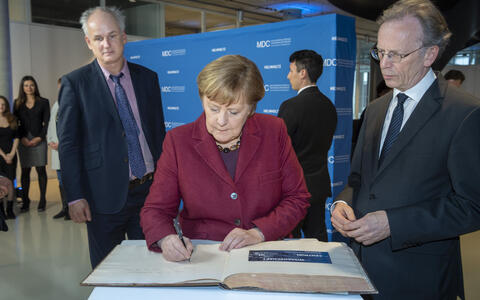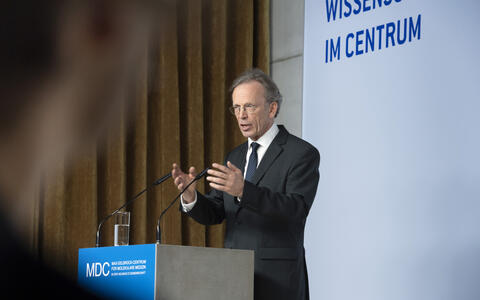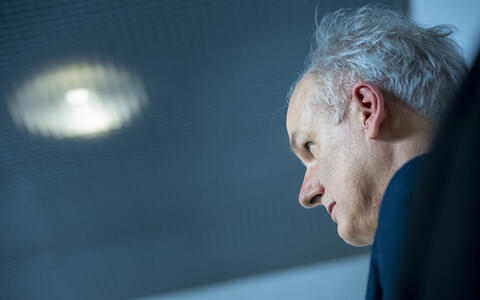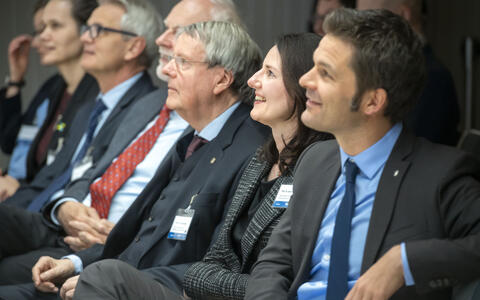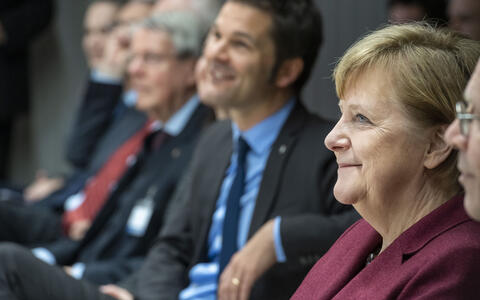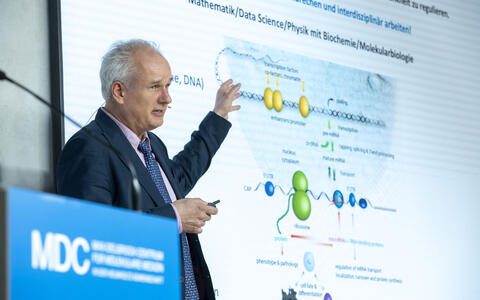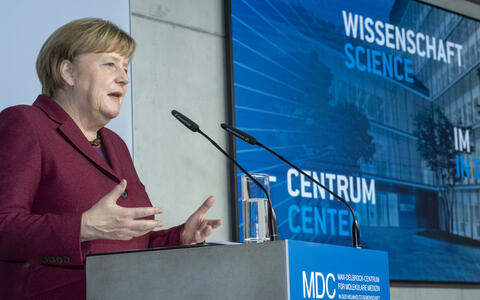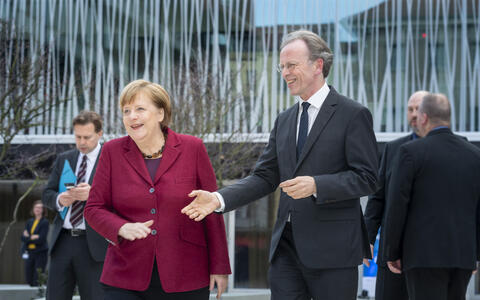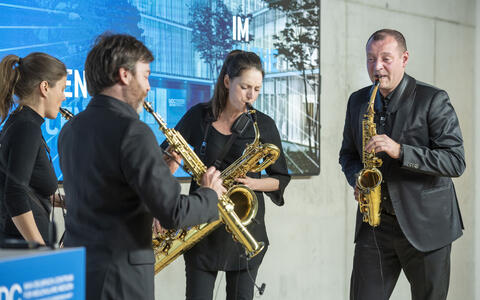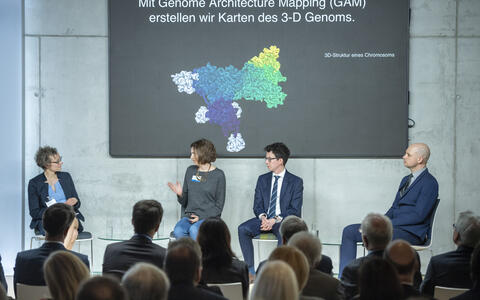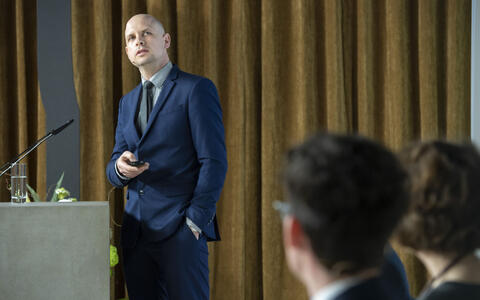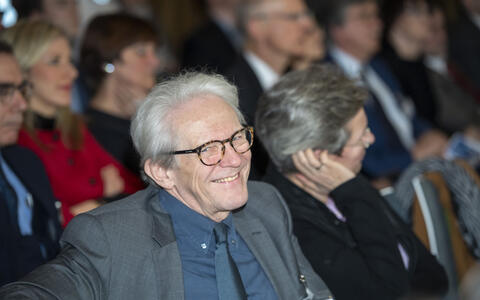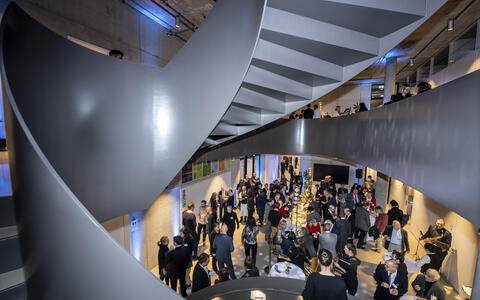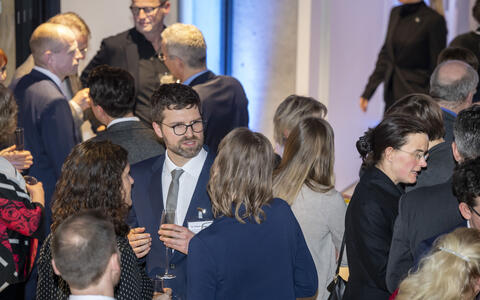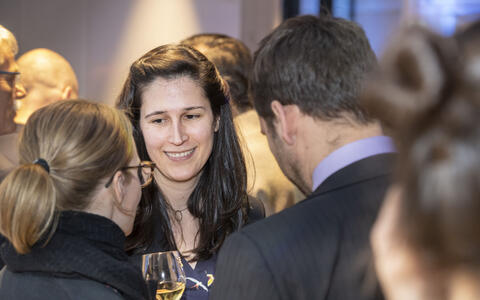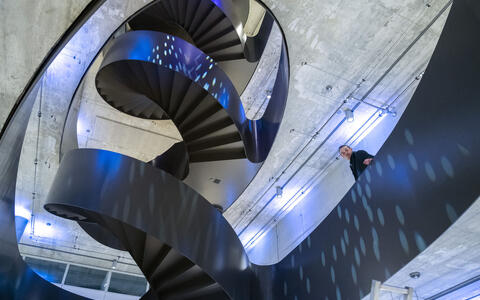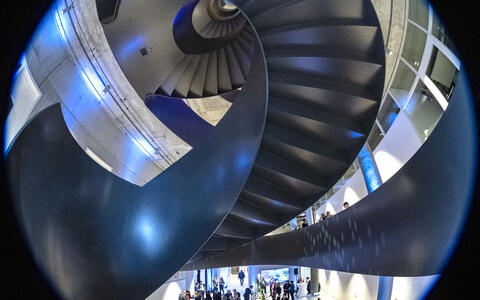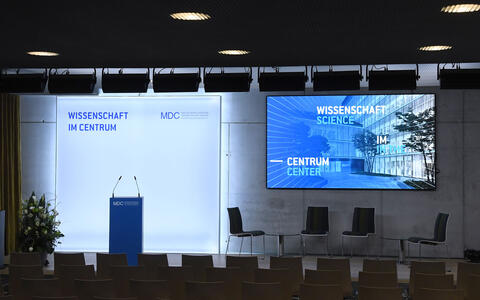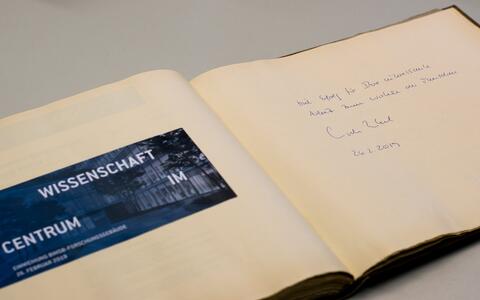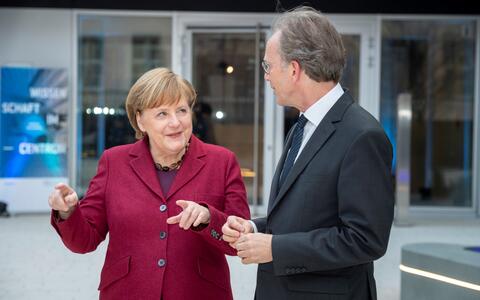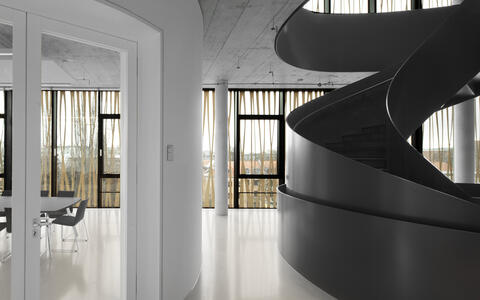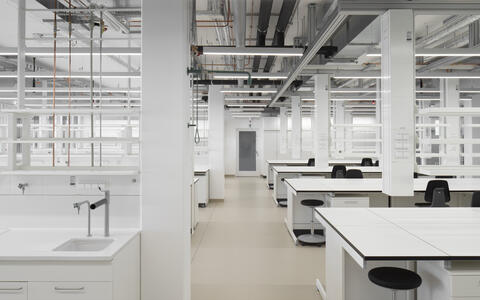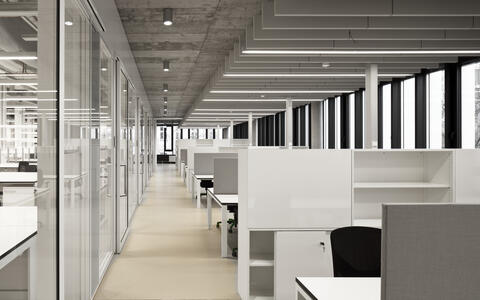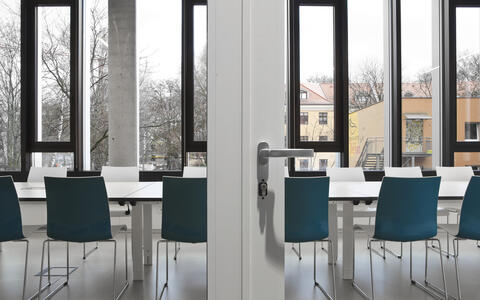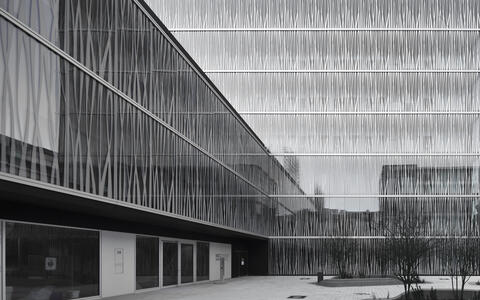Angela Merkel: “Be proud of your beautiful gem”
Science in the Center – Chancellor Angela Merkel at the Max Delbrück Center
“Be proud of your gem,” said Chancellor Angela Merkel. She was referring to the brand new research building, which was being ceremoniously opened today, a stone’s throw from existing ministries and hospitals.
With the new research and laboratory building for the Berlin Institute for Medical Systems Biology (BIMSB), the Max Delbrück Center for Molecular Medicine now has a second location in the heart of Berlin, in addition to the Buch campus. “This building is an example of how research can only be carried out across disciplines,” said the Chancellor.
It is important to work across the borders of institutions and countries
“Scientific excellence and internationality go hand in hand – it is important to work also across the borders of institutions and countries,” said Merkel. In the lab, she met three young scientists how explained their research on single cells. She said she would meet French President Emmanuel Macron tomorrow and “travel to Paris tomorrow to report on my experiences here” – not least because artificial intelligence is a focus of cooperation between the two countries.
The German government and the state of Berlin supported the BIMSB early on, said Merkel. As a pilot project of the funding initiative "Excellence in Research and Innovation in the New States", it shows what "has happened in thirty years of German unity and what has become possible". Health research is a particular concern of the government and she will personally support it, because “we have made long-term commitments and it is these commitments that determine our future.”
“Health research is a particular concern of the government”, said Chancellor Angela Merkel when she opened our new research building in the center of Berlin.
A house of the future
The open architecture of the new building stands for the future. It provides space for cutting-edge biomedical research that transcends borders. In the coming weeks, the building will become the new home of the 250 researchers and 16 labs of the Berlin Institute for Medical Systems Biology, who have up to now worked at the research campus in Berlin-Buch.
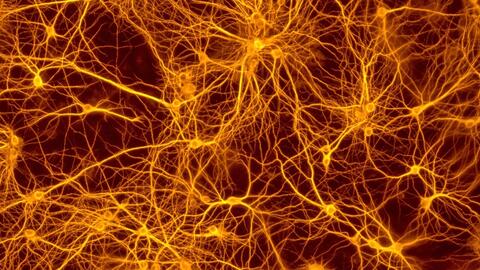
“Our new research building stands for a science that is wide open to the outside world,” said Professor Martin Lohse, Scientific Director of the MDC, at the opening ceremony. Teams across a range of disciplines will collaborate here under the motto of “breaking down borders.”
Jonathan Alles, Doktorand im Labor von Nikolaus Rajewsky (1.von links), erklärt Bundeskanzlerin Angela Merkel, wie man mit der Einzelzell-Analyse in großem Maßstab und hoher Präzision beobachten kann, welche Informationen Zellen gerade aus dem Erbgut abrufen.
Such an approach will enable researchers to overcome the traditional borders between disciplines such as biotechnology, computational science, biochemistry, molecular biology, and clinical research. “Today is a good day for us at the MDC, and for everyone who stands to benefit from our work,” said Lohse. “That means the patients of tomorrow and people who want to stay healthy.”
Collaborating on tomorrow’s medicine
Professor Nikolaus Rajewsky, initiator and head of BIMSB, said taking “a radical approach to collaboration” is extremely important for success. BIMSB combines to a unique degree experimental research with mathematical-theoretical work – a fundamental idea that Rajewsky articulated some ten years ago in his proposal to the Federal Ministry of Education and Research (BMBF).
A dream comes true for me personally
“For me, personally, this day is the culmination of a dream that started as an idea on paper and grew through more than ten years of exciting development work,” said Rajewsky. “For us, computational research – i.e., statistics and machine learning – is just as important as wet lab research that employs biochemistry, molecular biology, microfluidics, or even nanotechnology.”
Molecular barcodes for single cells
Chancellor Merkel discovered what this type of research looks like in practice on her tour of the labs, during which three young scientists presented their research. For example, Zoe Mendelsohn, a member of Nikolaus Rajewsky’s lab, is using miniature versions of human brains to study Alzheimer’s dementia and Huntington’s disease. These mini-organs, known as organoids, were produced with the aid of reprogrammed human skin cells.
Angela Merkel and Martin Lohse in conversation. The chancellor just opened the lab building for systems biology.
The mini-brains are only a few millimeters in size, so the Chancellor had to use a microscope to examine them. Organoids are three-dimensional cell cultures and enable researchers like Mendelsohn to understand the molecular mechanisms of diseases by providing simulations of patients’ diseased organs.
“One can analyze individually each cell in such an organoid, sequence the DNA, and determine which information the cell retrieves at that very moment,” explained Jonathan Alles, another researcher in Nikolaus Rajewsky’s lab. He constructed an apparatus that consists of computers, a microscope, and a bunch of tubes, which he connected with a synthetic chip. “Single-cell analysis is only possible with machines like these,” said Alles.
With such a microfluidics chip it's possible to single out individual cells from organoids or a tissue sample for sequencing
Chancellor Merkel got into the act and started a single-cell sequencing at the control computer. After a few seconds, droplets appeared on the monitor – each containing a single cell and a molecular barcode. These droplets are generated as a result of the microfluidic chip’s tiny and precisely fabricated channels.
Truly big data
Analyses like these generate huge amounts of data, or “truly big data,” in Rajewsky’s words. Researchers are familiar with many of the numerous processes that occur within cells, but often it remains unclear how they interact. It is a systems biology perspective that allows one to gain a holistic understanding of such interaction and thus also of complex diseases. “We’re learning how cells make decisions,” said Rajewsky. ‟But that’s not all: It’s even possible to predict how a cell will change over time.”
Researchers like Jonathan Ronen, a member of Altuna Akalin’s group, can mine such a vast treasure trove of data with bioinformatics, powerful algorithms, and self-learning computer programs. In other words, they are using artificial intelligence methods. On the tour of the labs, participants took a look at the only piece of equipment Ronen uses: a small laptop on whose screen several lines of programming code are displayed. With this, he can identify important genes, recognize patterns, and even devise new research questions.
Personalized medicine as the medicine of the future
Ronen and his colleagues have developed what they call a “Google for tumors.” The algorithm takes the sequencing data obtained from the tumor of a patient and searches in databases for known tumor types with similar properties. The program then predicts how the tumor cells will develop or which therapies would be effective in destroying the cells.
System biology thus offers enormous potential for personalized medicine, which represents the medicine of the future. That’s why the journal Science selected single-cell analysis as the 2018 Breakthrough of the Year. And also why the MDC is taking part in the LifeTime consortium, a billion-euro EU project in which 53 institutions and 80 companies are collaborating on the next revolution in medicine and which is being supported by Europe’s largest research organizations. The project, jointly coordinated by Rajewsky at the MDC and Geneviève Almouzni at the Institut Curie in Paris, has taken a leading position in the global research landscape. It will receive a million euros in March to finalize its project proposal.
But Rajewsky is already one step ahead. The groundwork for the next project of the future – the Berlin Cell Center – is already being laid in the fifth floor of the BIMSB building. Here clinical scientists and basic researchers are applying single-cell sequencing directly to diseases in order to pave the way for new diagnostics and therapies. “Various Berlin institutions must come together – like Harvard University and the Massachusetts Institute of Technology (MIT) have done in Boston – to make this happen,” said Rajewsky.
A place of collaboration and communication
Medical systems biology is a young and rapidly developing field of research. The architect Volker Staab therefore knew he had a special and exciting challenge when it came to designing the new BIMSB building. His task centered around one fundamental question: “How do we organize the work processes involved in research?” Staab said during the tour.
The spacious facilities take into account the “unforeseeable and constantly changing environment,” for which he planned as many computer workstations as lab spaces, but which can be flexibly converted back and forth. The open-plan work spaces function without walls and boundaries. Fair-faced concrete and robust materials radiate workshop atmosphere.
“We wanted that researchers would inevitably meet again and again,” is how the architect described the second requirement of the building, adding: “Because new ideas will only emerge if the different disciplines that the building brings together under one roof communicate and exchange knowledge.” A “central hub” in the form of a large hall, which contains a monumental spiral staircase made of dark metal, provides this communicative space. All other rooms can be accessed from here. The staircase functionally connects the facility’s various levels and forms the communicative center of the building.
Transparency toward the outside, too
The new structure is also open to the outside. The idea of transparency plays a fundamental role in its design and finds expression, for example, in the massive glass facade, which is printed with an organic-looking pattern. Evoking plant tendrils or DNA strands, the pattern helps reflect sunlight, which minimized the amount of vapor coating the architects had to use on the windows for solar protection. As a result, the facade is less reflective and allows glimpses into and out of the building through the glass.
Crossing and breaking down borders: That’s the motto of systems biology at the MDC, but it’s also that of Berlin, where for over two decades a wall separated two countries and two city halves – a wall that was eventually torn down by the people. BIMSB – which began as a initiative at the grassroots of the scientific community and earned exceptionally high marks in evaluations before securing permanent funding from the BMBF – also wants to break down barriers to the outside, challenge traditional thinking, and counteract the much-maligned “pillarization” of the German scientific system.
In the heart of the research hub of Berlin
There could hardly be a better place for the institute than the historic grounds of Humboldt-Universität zu Berlin (HU) in the heart of the city, which are also home to the HU’s Faculty of Life Sciences, Charité – Universitätsmedizin Berlin, the Integrative Research Institute (IRI) for the Life Sciences, and the Max Planck Institute for Infection Biology.
The building is a place of scientific thought and exchange of ideas in the research hub of Berlin
“With the BIMSB’s new location in Berlin Mitte, the MDC continues to pursue its integrative, systems biology approach,” said Lohse. “We are thereby taking on a more complex perspective regarding genes and cells.” Other approaches to understanding health and disease will continue to be mainly based in Buch. This includes the study of the body’s molecules, their structure, and how they interact with each another, or the “physiological” route via animals, human subjects, and tissue samples taken from patients.
“The motto of the opening ceremony, ‘Science in the Center,’ has at least a double meaning,” said Lohse. “For the new building, finally, not only gives the MDC a location in the center of Berlin, but the MDC has for many years been working to establish biomedical research in the center of society.” He added that the new location is also “a place for discussion and communication – a place of scientific thought and exchange of ideas in the research hub of Berlin.”
Further Information
Website „Science in the Center“
Berliner Institut für Medizinische Systembiologie
The Max Delbrück Center for Molecular Medicine (MDC)
The Max Delbrück Center for Molecular Medicine in the Helmholtz Association (MDC) is one of the world’s leading biomedical research institutions. Max Delbrück, a Berlin native, was a Nobel laureate and one of the founders of molecular biology. At the MDC’s locations in Berlin-Buch and Mitte, researchers from some 60 countries analyze the human system – investigating the biological foundations of life from its most elementary building blocks to systems-wide mechanisms. By understanding what regulates or disrupts the dynamic equilibrium in a cell, an organ, or the entire body, we can prevent diseases, diagnose them earlier, and stop their progression with tailored therapies. Patients should benefit as soon as possible from basic research discoveries. The MDC therefore supports spin-off creation and participates in collaborative networks. It works in close partnership with Charité – Universitätsmedizin Berlin in the jointly run Experimental and Clinical Research Center (ECRC), the Berlin Institute of Health (BIH) at Charité, and the German Center for Cardiovascular Research (DZHK). Founded in 1992, the MDC today employs 1,600 people and is funded 90 percent by the German federal government and 10 percent by the State of Berlin.
- Berlin Institute for Medical Systems Biology (BIMSB)
-
-
Since 2008, the Berlin Institute for Medical Systems Biology (BIMSB) has expanded the research profile of the Max Delbrück Center for Molecular Medicine (MDC). BIMSB received initial funding from the Federal Ministry of Education and Research (BMBF) and the Berlin Senate as a pilot project under the Cutting-Edge Research in the New Federal States initiative and, after a successful evaluation by the BMBF, secured permanent funding. It is moving into its own building in the center of Berlin in early 2019. This new building has also been jointly funded by the Berlin Senate and the BMBF.

